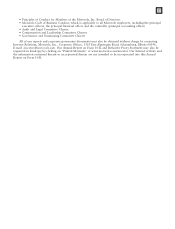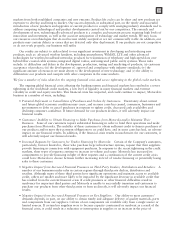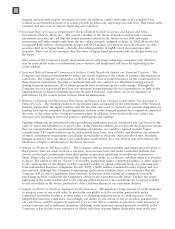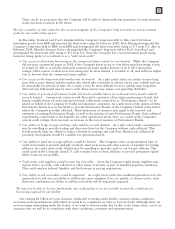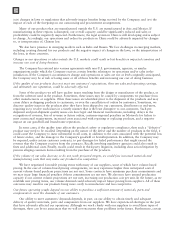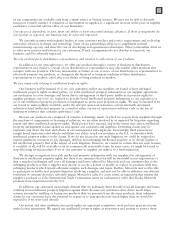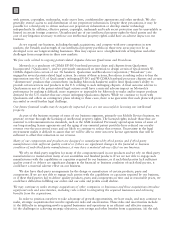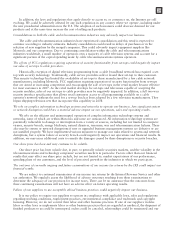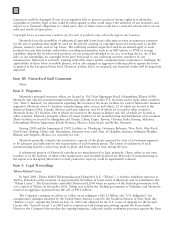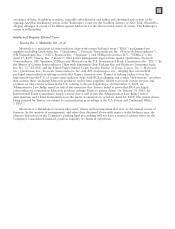Motorola 2008 Annual Report Download - page 35
Download and view the complete annual report
Please find page 35 of the 2008 Motorola annual report below. You can navigate through the pages in the report by either clicking on the pages listed below, or by using the keyword search tool below to find specific information within the annual report.
that our markets do not evolve as anticipated and that the technologies acquired do not prove to be those needed
to be successful in those markets; (iv) the potential loss of key employees of the acquired businesses; (v) the risk of
diverting the attention of senior management from our operations; (vi) the risks of entering new markets in which
we have limited experience; (vii) risks associated with integrating financial reporting and internal control systems;
(viii) difficulties in expanding information technology systems and other business processes to accommodate the
acquired businesses; and (ix) future impairments of goodwill of an acquired business.
Acquisition candidates in the industries in which we participate may carry higher relative valuations (based on
their earnings) than we do. This is particularly evident in software and services businesses. Acquiring a business
that has a higher valuation than Motorola may be dilutive to our earnings, especially when the acquired business
has little or no revenue. In addition, we may not pursue opportunities that are highly dilutive to near-term earnings
and have, in the past, foregone certain of these acquisitions.
Key employees of acquired businesses may receive substantial value in connection with a transaction in the
form of change-in-control agreements, acceleration of stock options and the lifting of restrictions on other equity-
based compensation rights. To retain such employees and integrate the acquired business, we may offer additional
retention incentives, but it may still be difficult to retain certain key employees.
The value of our investments in the securities of various companies fluctuates and it may be difficult for us to
realize the value of these investments.
We hold a portfolio of investments in various companies. Since the majority of these securities represent
investments in technology companies, the fair market values of these securities are subject to significant price
volatility. In addition, the realizable value of these securities is subject to market and other conditions.
We also have invested in numerous privately-held companies, many of which can still be considered in startup
or developmental stages. These investments are inherently risky as the market for the technologies or products they
have under development are typically in the early stages and may never materialize. We could lose all or
substantially all of the value of our investments in these companies, and in some cases have.
The Sigma Fund holds U.S. Dollar-denominated debt obligations which include, among other securities,
corporate bonds, asset- and mortgage-backed securities. As issuers of these securities continue to be negatively
impacted by the weakened global economic environment and dislocation in the financial markets, the total fair
value of the Sigma Fund holdings is less than its total original cost. The fair value of these holdings may experience
further declines due to the widening credit spreads in several debt market segments or if the underlying debtors
should default on their obligations. Such events could result in additional temporary unrealized losses or
impairment charges in the Sigma Fund investments.
It may be difficult for us to recruit and retain the types of highly-skilled employees that are necessary to remain
competitive.
Competition for key technical personnel in high-technology industries is intense. We believe that our future
success depends in large part on our continued ability to hire, assimilate, retain and leverage the skills of qualified
engineers and other highly-skilled personnel needed to compete and develop successful new products. We may not
be as successful as our competitors at recruiting, assimilating, retaining and utilizing these highly-skilled personnel.
In particular, we may have more difficulty attracting or retaining highly-skilled personnel during periods of poor
operating performance, and as a result of recent actions to suspend the Company’s 401(k) contributions to
employee accounts, permanently freeze all future benefit accruals under U.S. pension plans and eliminate merit
increase programs in the U.S. and many other markets.
The unfavorable outcome of litigation pending or future litigation could materially impact the Company.
Our financial results could be materially adversely impacted by unfavorable outcomes to any pending or
future litigation. See “Item 3—Legal Proceedings.” There can be no assurances as to the favorable outcome of any
litigation. In addition, it can be very costly to defend litigation and these costs could negatively impact our
financial results.
We are subject to a wide range of product regulatory and safety, consumer, worker safety and environmental laws.
Our operations and the products we manufacture and/or sell are subject to a wide range of global laws.
Compliance with existing or future laws could subject us to future costs or liabilities, impact our production
capabilities, constrict our ability to sell, expand or acquire facilities, and generally impact our financial
27


